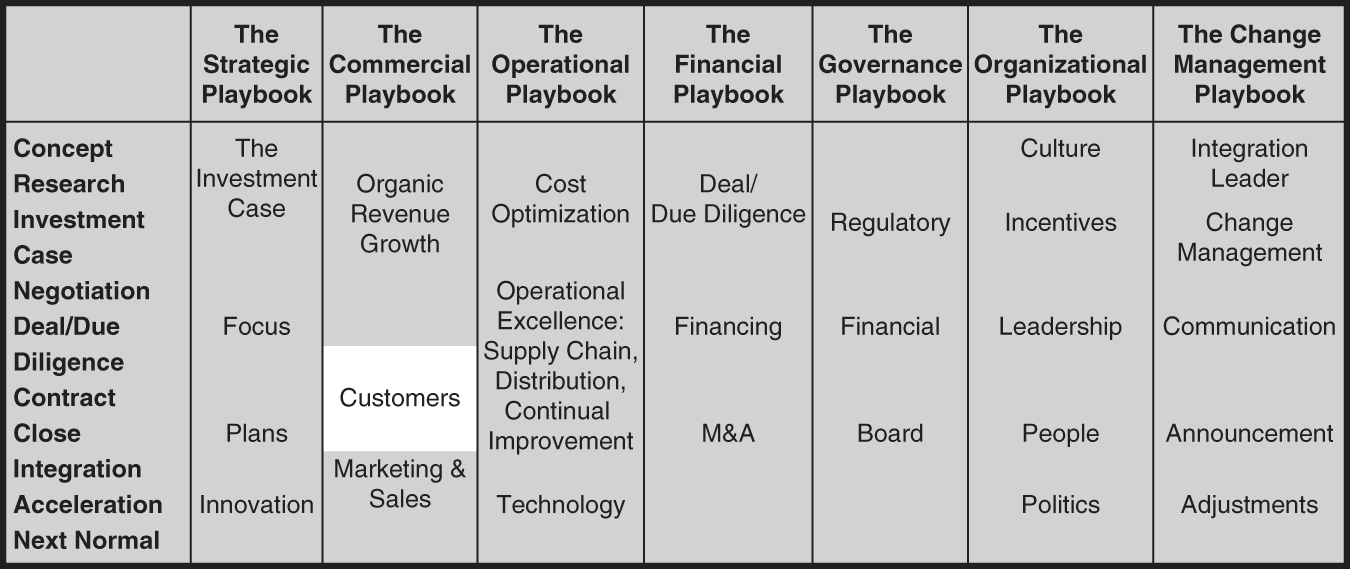CHAPTER 6
Customers: From Which All New Value Flows

The customers component of the commercial playbook goes into more depth on this aspect of organic revenue growth. A key focus of a mergers and acquisitions (M&A) deal or private equity (PE) investment is around incremental organic revenue growth.
The most important point in this chapter is to reinforce the approach of working through customers, people, capabilities, and costs—in that order. First, figure out how you're going to win with customers. This chapter is all about customers.
Customers are the people your organization sells to or serves or could sell to. These comprise direct customers who actually give you money, along with their customers, their customers' customers, and so on down the line. Eventually, there are end users or consumers of whatever the output of that chain is. Additionally, there are the people who influence your various customers' purchase decisions. Take all of these into account from the consumer back.
Consumers are the people that actually ingest, wear, use, or experience your product or service. They are the ultimate C in a chain of SIPOCs (supplier–input–process–output–customer). They add no value to your product or service, no further design, no further production, no further distribution, no further service. When they are done, your product or service is consumed.
Start with them. Figure out their needs, hopes, and desires. Figure out what other product or services they might consume instead of yours. Figure out the value you add to their lives or businesses and what they would be willing to pay for that—the value equation. It is important to think through technology disruption and how to stay ahead of the competition (even those competitors who don't exist today), discussed more in other chapters.

Relative perceived value = function of relative perceived benefits / relative perceived costs
The ultimate benefits are emotional feelings derived from positive features. Costs include money, time, and stress.
Who or what would you say are Coca-Cola and Walt Disney World's main competitors? (Hint: it's not Pepsi and Universal Studios.) We're oversimplifying a little to make a point. But when a Coca-Cola–drinking 12-year-old walks into a convenience store with a pocket full of change, their real decision is not Coke versus Pepsi but, rather, Coke versus a bar of chocolate or an ice cream popsicle.
Actually, Coke has different competitors in different situations. The 12-year-old is looking for a treat. Someone getting off a soccer pitch after a hard workout is looking for liquid replenishment. A worker trying to stay awake in the middle of the afternoon is looking for energy. And so on.
Disney World's main competitor is college educations. It turns out many middle-income families put aside money each year to pay for their children's college education. Some of them will take 1 year and use that year's savings to pay for a once-in-a-lifetime trip to Disney World.
Of course, in that example, the parents are partly consumers and, even more importantly, the purchasers.
Purchasers
Purchasers pay money. Dogs consume dog food, but they don't purchase it. Of course, in some cases like the Disney trip, purchasers are consumers as well. But it's often helpful to think about them differently.
Strategic Sales
One of the key steps in the Miller Heiman methodology of the strategic selling process is identifying the buying influences involved (economic, user, technical, coach):
- Economic buyers give final approval as the single person or group who can say yes when others say no and can veto other buyers' approval.
- User buyers use the product and, as their success is tied to it, make judgments about impact. There may be several.
- Technical buyers screen out options. They focus on the product and service, can't give final yes, but often give a final no. There may be several technical buyers at the same time.
- Coaches help you navigate the buying organization and identify other buying influences. They may work for the buying organization, your organization, or neither.
We could go into more detail on this—but you know enough to go on to the next chapter.
